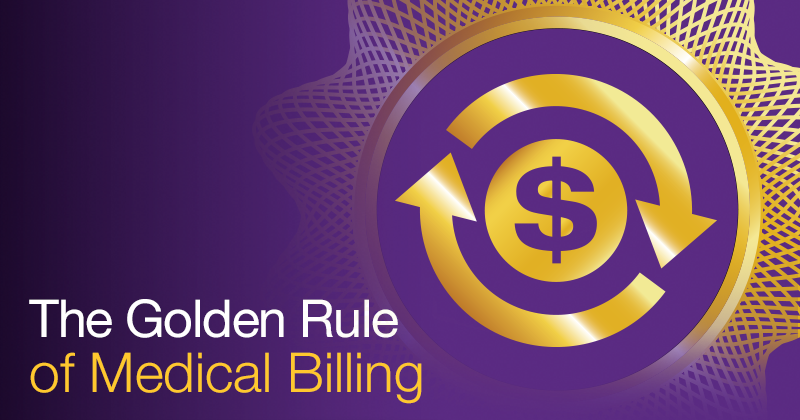The Vital Role of Coding Compliance and Proper Medical Record Documentation

Does the documentation justify the medical coding?
The Golden Rule of Medical Billing
When I began my billing and coding career, providers did not have electronic health record (EHR) systems, and coders had to review paper charts with illegible notes and charge slips. Thank goodness those days are over and we have EMA™ and gGastro® EHR! I recall one of my favorite quotes mentioned by a coding colleague, who happens to be a clinical documentation specialist, which is “documentation drives coding.” For a coder, this is the golden rule to follow. Now what does this rule mean? Simply put, if it is not documented, it was not done. Accurate and compliant documentation will lead the way to correct assignment of codes. In turn, this can help provide the client with maximum reimbursement, lower denial rates, compliance and peace of mind.
As a coder, when reviewing documentation, you should ask yourself, “Does the documentation justify the coding?” Keep in mind, documentation is considered poor or subpar if it lacks sufficient specificity for the coder to assign accurate ICD-10-CM, CPT, HCPCS codes and/or modifiers.
What Constitutes Insufficient Medical Record Documentation Errors?
According to the CMS MLN Fact Sheet, “Complying With Medical Record Documentation Requirements,” insufficient documentation errors identified by the Comprehensive Error Rate Testing (CERT) Review Contractor may include:
- Incomplete progress notes, for example, unsigned, undated, or insufficient detail
- Unauthenticated medical records, for example, no provider signature, no supervising signature, illegible signatures, without a signature log or attestation to identify the signer, or an electronic signature without the electronic record protocol or policy that documents the process for electronic signatures
- No documentation of intent to order services and procedures, for example, incomplete or missing order or progress note describing intent for services to be provided
CERT was implemented by the Centers for Medicare & Medicaid Services (CMS) and measures improper payments in the Medicare FFS program. The CERT program consists of two contractors:
- CERT Review Contractor (RC)
- CERT Statistical Contractor (SC)
Why ICD-10-CM Can Prove Challenging?
In my opinion, ICD-10-CM coding can be the most challenging coding set, as there are so many guidelines to review and think about when assigning a code. Remember, one of the rationales for implementation of ICD-10-CM included the ability to capture more specified coding of diseases. This specificity is now a requirement for many payers, including Medicare, whose allowance of most unspecified codes ended on October 1, 2016. This forces providers to be more specific with their documentation, so that it supports a more specific diagnosis code.
Below is a limited list of documentation requirements for compliant coding to be justified.
- Signed, dated and finalized notes (a certified coder should never code from an unsigned note)
- Updates to procedure reports should be done as a signed and dated addendum, NOT as a revision to the existing note (addendum should reference original DOS)
- Proper documentation of all procedures performed should be done to allow for correct CPT code selection
- Proper documentation of diagnoses should be to the highest documented level of specificity to allow for correct ICD-10-CM code selection
- For the office or outpatient services, NEVER code from a “rule out,” “comparable to,” “suggestive of,” or equivalent statement; if a definitive diagnosis is not determined, report symptoms and/or signs instead.
Why You Need Accurate Medical Billing Documentation
Top-notch medical billing documentation is a must for many reasons. For one, it exists as a legal document which will prove the services rendered, as well as why those services were rendered and/or why the patient was seen by the provider. The documentation may also serve as evidence in a court of law. Excellent notation will also serve as effective communication of your plan of care and thinking to other providers in a professional manner. For medical billing purposes, it will provide solid documentation of the service(s) rendered, which can then be confidently and compliantly billed.
Sources
Centers for Medicare and Medicaid Services (CMS). “Comprehensive Error Rate Testing (CERT).” https://www.cms.gov/Research-Statistics-Data-and-Systems/Monitoring-Programs/Medicare-FFS-Compliance-Programs/CERT/. Published November 29, 2018. Accessed January 14, 2019.
Centers for Medicare and Medicaid Services (CMS). Medicare Learning Network® (MLN) Fact Sheet: Complying With Medical Record Documentation Requirements. https://www.cms.gov/Outreach-and-Education/Medicare-Learning-Network-MLN/MLNProducts/Downloads/CERTMedRecDoc-FactSheet-ICN909160.pdf. Published April 2017. Accessed January 14, 2019.
Centers for Medicare and Medicaid Services (CMS). Comprehensive Error Rate Testing (CERT). https://www.cms.gov/Research-Statistics-Data-and-Systems/Monitoring-Programs/Medicare-FFS-Compliance-Programs/CERT. Published November 29, 2018. Accessed January 14, 2019.
